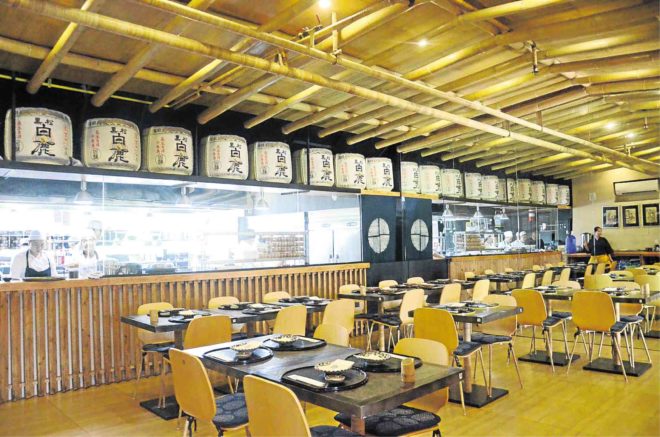
If the measure of a Japanese restaurant’s authenticity is the impressive head count of Japanese diners on any given day, consider the barely eight-month-old Miyazaki in Alabang, Muntinlupa, as your personal wormhole to Tokyo.
With a menu carrying more than 300 entrées, along with the meticulous interiors, dinnerware and wait staff’s uniforms, all that Miyazaki needs is a karaoke blasting J-Pop songs to convince expat customers—
some coming all the way from the industrial techno-parks in Laguna—that they are home.
Head chef Koichi Kondo’s concept is intentional. “It is his idea to target Japanese customers. They look for a certain dish, and chef Kondo wants that on the menu,” said Anna Blardony, niece of restaurant owner Susan Cuenca.
And Kondo certainly doesn’t joke about serving one’s food craving. On one occasion, a Japanese executive who braved the South Luzon Expressway traffic for a bite of in-demand battera or marinated mackerel flown from Norway that had just run out of stock.
“He did not look for anything else, just got angry and went home,” Kondo recalled.
Had the guy stayed to check the rest of the menu, he would have found a new favorite from the list that Kondo tweaks every three months.

Crowd-drawers
The self-effacing chef recently served Inquirer Lifestyle a mix of crowd-drawers and soon-to-be-released items that he developed.
(Kondo, who has lived for 31 years in Manila, works as consultant at the Heny Sison Culinary School. Learning to cook at age 18 from his mother, he went on to earn a certificate in Japan and boasts a license to prepare and serve the legendary fugu or blowfish. His license proudly hangs in a corner of Miyazaki.)
Mango Gyu Maki is a sweet and salty appetizer that wraps thin, grilled beef slices around tasty mango cubes.
Matsu sashimi is a mind-boggling sashimi set of 11 assorted seafood, including old reliables like Hamachi, salmon, tuna, mackerel, uni, sweet shrimp and squid.
To eat the local dapa sashimi that is folded like a flower, Kondo said I should begin with the outer petals and work my way in. The talakitok and lapu-lapu were very firm. Kondo insisted that the lemon-infused scallops be dipped first in his special soy sauce before eating.
The uni or sea urchin was brought all the way from Bicol, Kondo announced. The region “has sweet uni,” he noted.
There is no other way to describe it—the uni moved around the mouth like a sensuous tongue.
As for the battera that drove a customer craving-mad, Kondo is obviously proud of his personal invention—a box-shaped sushi that is better eaten by hand instead of handled with chopsticks. I took a cautious bite and wondered, “where have you been all my life?”
To fully enjoy the battera meant not listening to Kondo as he explained why the oilier Norwegian mackerel works better with the fragrant rice, instead of Japan-sourced mackerel.
The saltiness of the fish conversed eloquently with the sweetness of the rice.
I refused the chef’s invitation to dip it in yet another special sauce (Kondo creates individual sauces for his dishes) because some joys are meant to be simple.
Kondo originals
Next came the yet-to-debut Kinshi Sumaki, another Kondo original that puts together fresh slivers of lapu-lapu, salmon, boiled shrimp and radish inside a delicate ribbon of omelet. Kondo could have used nori wrapper, but the egg worked better with his piquant sweet and sour sauce.
Maguro Tataki, another dish waiting to be unveiled, is pan-seared tuna sprinkled with black sesame seeds and crispy garlic chips that could serve as pulutan for a fresh pint of single-malt Yamazaki whisky.
The tuna tasted like meat, the sauce not overwhelming and the lato (seaweed) mixed in made a pop-pop-pop sound when chewed.
At this point, I was reaching full tank and could hardly look at Kondo who was watching me intently.
He pushed the plate of Kani Fornia Maki (a sushi roll made of mango and cucumber slices, crab meat and fish roe) toward me and motioned for me to take a piece by the hand and take it all in one bite.
The crab slices and fish roe crunched like well-behaved nachos, probably because the sound was toned down by the creamy mayonnaise.
At this point I was sated, but the Wagyu Steak Teppan awaited. The extra-warm beef cubes were served with mixed veggies on an iron griddle. The waitress served a bowl of Seafood Chahan
—fried rice mixed with seafood—and glazed Ebi Gyoza.
The gyoza revealed luscious, sweet and salty prawn in one bite. My eyes were half-closed by the time the grilled Gindara Teriyaki in “special sweet sauce” arrived.
Food exports
Kondo first arrived in Manila in 1986 to set up a food export business. Japanese cuisine would soon be the craze.
Kondo’s Manila-based company exports seafood to Hong Kong, Japan and the United States. Miyazaki owner Susan Cuenca is a colleague in the export business. They have been friends for 30 years.
“Tita Susan believes in chef Kondo. She was the one who said, ‘Kondo-san, let’s open a Japanese restaurant,” Blardony said.
The idea was simple enough: give diners an authentic Japanese experience.
“Japanese fusion cuisine allows foreign elements,” Kondo lamented. “Here, everything is fresh, clean and authentic.”
Kondo then stood up to welcome some regulars. From out-of-town perhaps? Yes, Blardony confirmed with a smile. “They come here during lunch, dinner, happy hour…” she trailed off.

